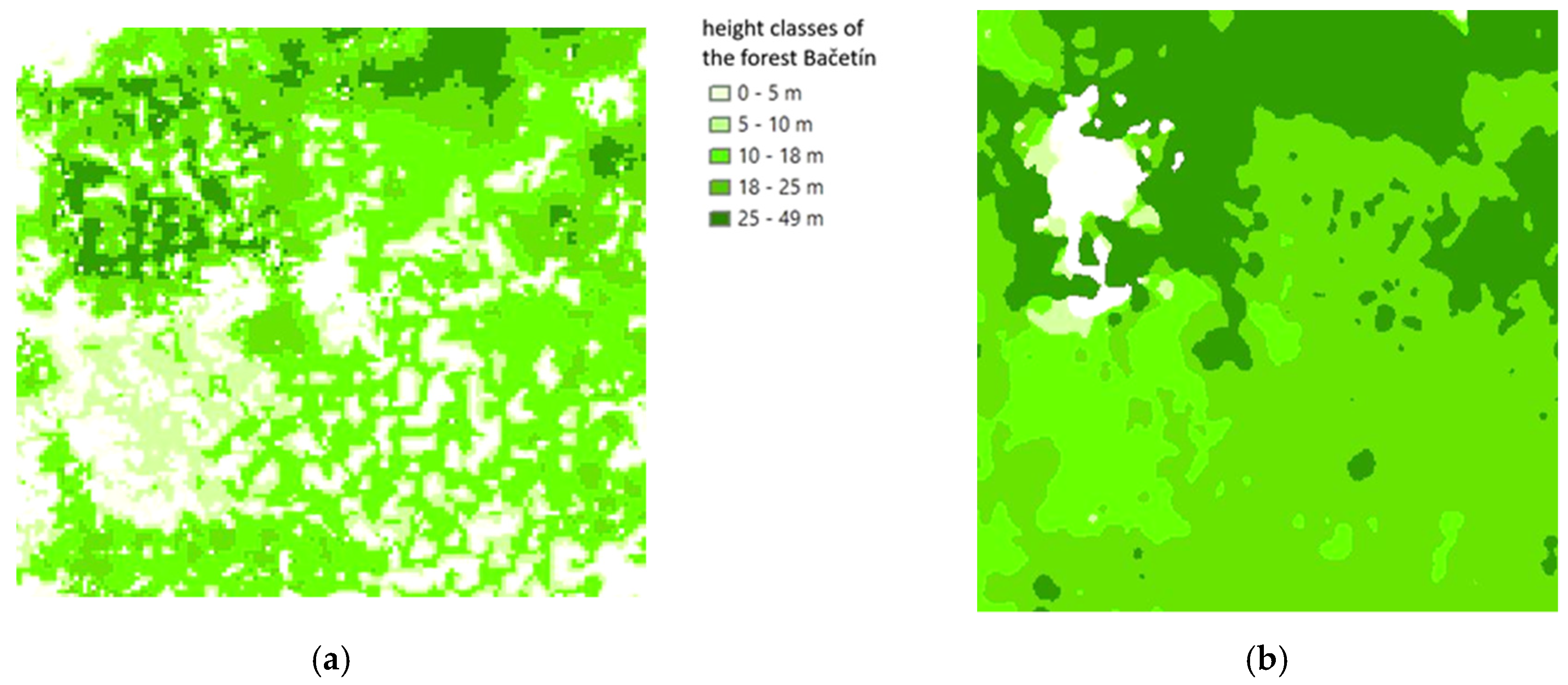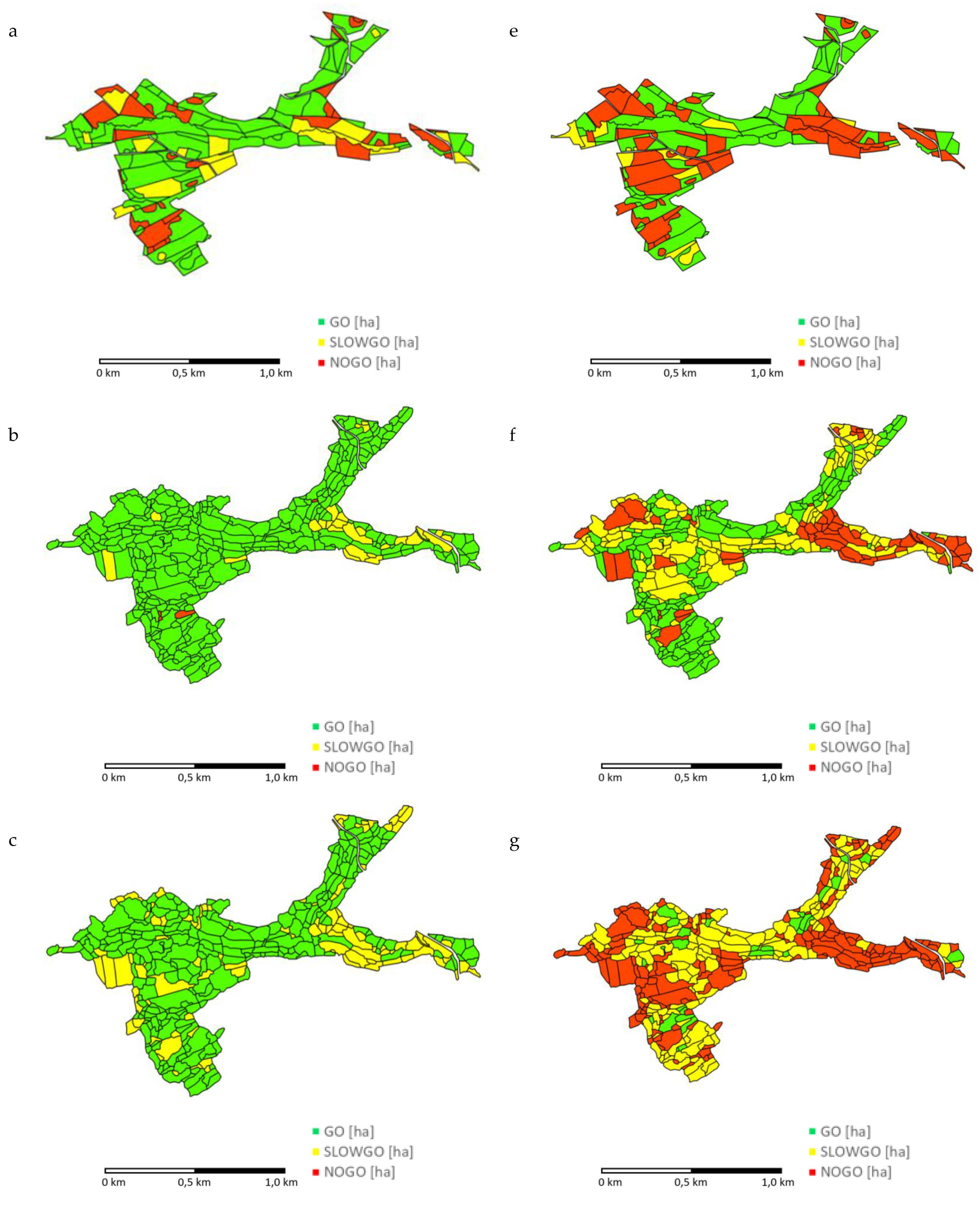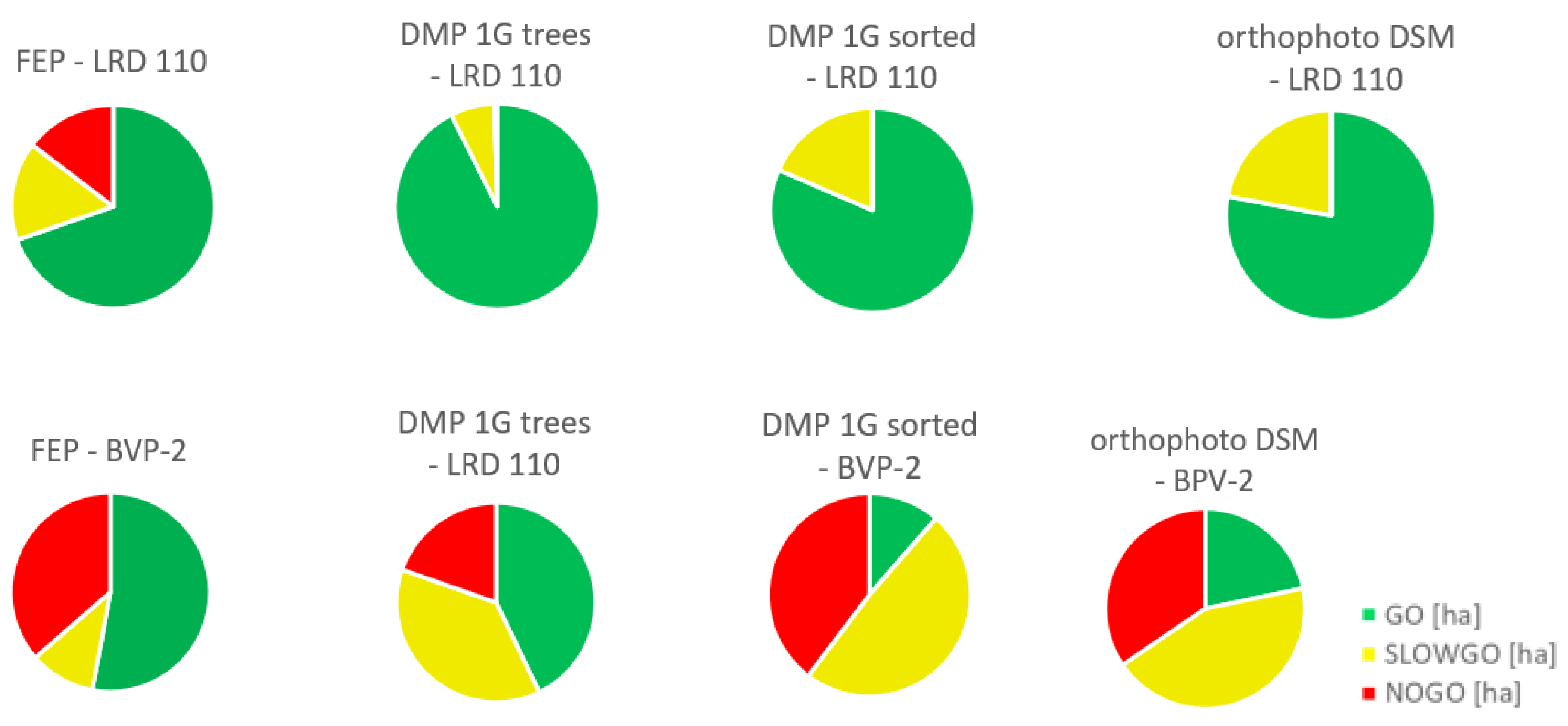Influence of Quality of Remote Sensing Data on Vegetation Passability by Terrain Vehicles
Abstract
:1. Introduction
- particular degrees of CCM;
- typology of terrain practicability by kind of military vehicles;
- geographic factors and features with significant impact on CCM;
- other factors (technical, personnel, environmental, etc.).
- passable terrain (GO);
- terrain passable with restrictions (SLOW GO);
- impassable terrain (NO GO).
2. Method of Investigation
3. Analysis of Methodology and Data
3.1. Forest Economic Plan Database
3.2. Data Based on Digital Surface Model 1st Generation
- (1)
- Reclassify—classifies raster data of the forest heights to 5 classes.
- (2)
- Zonal statistics-majority—calculates majority of a class in inner zones of the forest.
- (3)
- Less than and set null—erases lower heights pixels (than calculated majority) of the forest in each zone.
- (4)
- Zonal statistics-mean—calculates a mean height in each zone of remaining pixels.
3.3. Digital Surface Model Created from Orthophoto
3.4. Evaluation of Passability
- if T < 0, then passability = NO GO;
- if T = ⟨0, 1⟩, then passability = SLOW GO;
- if T > 1, then passability = GO.
4. Results and Discussion
4.1. Evaluation of Boundaries within Forests
4.2. Evaluation of Databases and Methods of Processing
4.2.1. FEP Database
4.2.2. DSM 1G
4.2.3. DSM Created from Orthophoto
4.2.4. Comparison of Databases
4.3. Data Quality Assesed from CCM Analyses
- DSM 1G sorted into 5 classes.
- DMS 1G processed with Flow analysis to positions of trees.
- FEP database.
- FEP database has a small coverage of data in the Czech Republic, and less than 20% of forests are included. At present, the dataset is not globally useable because some regions do not have any information about forests filled in. After the data covers majority of the Czech territory, it can serve CCM and other analyses connected with a forest evaluation.
- Regular updates of characteristics of forests in FEP database must be secured to ensure a higher level of accuracy of information.
- DSM 1G is getting outdated. Data exported from DSM 1G has to be properly processed to assure, e.g., updated heights of trees in the form of corrections to actual real values.
- A suitable methodology is a crucial part of DSM 1G processing, for the most part, conversion from height of trees to number of trees per hectare. New methods for utilization of growth tables of forests for the purpose of DSM processing should be created.
- DSM created from orthophoto is accurate and up to date, yet it’s complicated and long-winded processing limits wider usability. The process of capturing, processing and evaluating data has to be automated. Otherwise, the time and capacity consumption are overly extensive.
5. Conclusions
Author Contributions
Funding
Acknowledgments
Conflicts of Interest
References
- Hansen, M.C.; Potapov, P.V.; Moore, R.; Hancher, M.; Turubanova, S.A.; Tyukavina, A.; Thau, D.; Stehman, S.V.; Goetz, S.J.; Loveland, T.R.; et al. High-resolution global maps of 21st-century forest cover change. Science 2013, 342, 850–853. [Google Scholar] [CrossRef] [PubMed] [Green Version]
- Ahlvin, R.B.; Haley, P.W. NATO Reference Mobility Model, 2nd ed.; NRMM II User’s Guide; TR GL-92-190; US Army Engineer Waterways Experiment Station: Vicksburg, MS, USA, 1992. [Google Scholar]
- Cibulova, K. The Mobility during Crisis Situations. Key Eng. Mater. 2017, 755, 236–241. [Google Scholar] [CrossRef]
- Dohnal, F.; Hubáček, M.; Šturcová, M.; Bureš, M.; Šimková, K. Identification of Microrelief Shapes Along the Line Objects Over DEM Data and Assessing Their Impact on the Vehicle Movement. In Proceedings of the 2017 International Conference on Military Technologies (ICMT), Brno, Czech Republic, 31 May–2 June 2017; pp. 262–267. [Google Scholar]
- Hošková-Mayerová, Š.; Talhofer, V.; Hofmann, A.; Kubíček, P. Spatial Database Quality and the Potential Uncertainty Sources. In Advanced Dynamic Modeling of Economic and Social Systems, Studies in Computational Intelligence; Springer: Berlin/Heidelberg, Germany, 2013; Volume 448, pp. 127–142. [Google Scholar] [CrossRef]
- Hubáček, M.; Kovařík, V.; Talhofer, V.; Rybanský, M.; Hofmann, A.; Břeňová, M.; Čeplová, L. Modelling of geographic and meteorological effects on vehicle movement in the open terrain. In Central Europe Area in View of Current Geography; Masarykova univerzita: Brno, Czech Republic, 2016; pp. 149–159. [Google Scholar]
- Pokonieczny, K. Automatic military passability map generation system. In Proceedings of the 2017 International Conference on Military Technologies (ICMT), Brno, Czech Republic, 31 May–2 June 2017; pp. 285–292. [Google Scholar]
- Rybanský, M. Modelling of the Geographical Factors Influence on the Cross-Country Movement (in Czech). Habilitation’s Thesis, VA Brno, Brno, Czech Republic, 2002; p. 477. [Google Scholar]
- Rybanský, M. Effect of the Geographic Factors on the Cross Country Movement during Military Operations and the Natural Disasters. In International Conference on Military Technologies 2007; University of Defence: Brno, Czech Republic, 2007; pp. 590–596. ISBN 978-80-7231-238-2. [Google Scholar]
- Rybanský, M. The Cross—Country Movement—The Impact and Evaluation of Geographic Factors; CERM: Brno, Czech Republic, 2009; p. 113. ISBN 978-80-7204-661-4. [Google Scholar]
- Rybanský, M. Modelling of the optimal vehicle route in terrain in emergency situations using GIS data. In 8th International Symposium of the Digital Earth (ISDE8) 2013; IOP Conf. Series; Earth Environmental Science 18 012071: Kuching, Malaysia, 2014. [Google Scholar] [CrossRef] [Green Version]
- Shoop, S.A.; Richmond, P.W.; Lacombe, J. Overview of cold regions mobility modeling at CRREL. J. Terramechanics 2016, 43, 1–26. [Google Scholar] [CrossRef]
- STANAG 3992-AGeoP-1 Terrain Analyses, Field Manual No. 5-33; Headquarters Department of the Army: Washington, DC, USA, 1990.
- Stodola, P.; Mazal, J. Optimal Location and Motion of Autonomous Unmanned Ground Vehicles. WSEAS Trans. Signal Process. 2010, 6, 68–77. [Google Scholar]
- Taheri, S.; Sandu, C.; Taheri, E.P.; Pinto, E.; Gorisch, D. A technical survey on Terramechanics models for tire–terrain interaction used in modeling and simulation of wheeled vehicles. J. Terramechanics 2015, 57, 1–22. [Google Scholar] [CrossRef]
- Hyyppä, J.; Hyyppä, H.; Litkey, P.; Yu, X.; Haggrén, H.; Rönnholm, P.; Pyysalo, U.; Pitkänen, J.; Maltamo, M. Algorithms and methods of airborn laser scanning for forest measurement. Int. Arch. Photogramm. Remote Sens. 2004, 36, 82–89. [Google Scholar]
- Blair, J.; Rabine, D.L.; Hofton, M.A. The Laser Vegetation Imaging Sensor: A medium-altitude, digitisation-only, airborne laser altimeter for mapping vegetation and topography. ISPRS J. Photogramm. Remote Sens. 1999, 54, 115–122. [Google Scholar] [CrossRef]
- Lim, K.; Treitz, P.; Wulder, M.; St-Onge, B.; Flood, M. LiDAR remote sensing of forest structure. Prog. Phys. Geogr. Earth Environ. 2003, 27, 88–106. [Google Scholar] [CrossRef] [Green Version]
- Heurich, M.; Persson, A.; Holmgren, J.; Kennel, E. Detecting and measuring individual trees with laser scanning in mixed mountain forest of central Europe using an algorithm developed for Swedish boreal forest conditions. Int. Arch. Photogramm. Remote Sens. Spat. Inf. Sci. 2004, 36 (Pt 8), W2. [Google Scholar]
- Aschoff, T.; Spiecker, H. Algorithms for the automatic detection of trees in lasser scanner data. Int. Arch. Photogramm. Remote Sens. 2004, 36, 71–75. [Google Scholar]
- Gobakken, T.; Næsset, E. Effects of forest growth on laser derived canopy metrics. Int. Arch. Photogramm. Remote Sens. 2004, 36, 224–227. [Google Scholar]
- Carson, W.W.; Andersen, H.E.; Reutebuch, S.E.; McGaughey, R.J. Lidar Applications in Forestry—An Overview. In Proceedings of the ASPRS Annual Conference, Denver, CO, USA, 23–28 May 2004. [Google Scholar]
- Ahlberg, S.; Söderman, U.; Tolt, G. High Resolution Environment Models from Sensor Data 2006. In Proceedings of the Defence Imagery Exploitation 2006, London, UK, 17–18 October 2006. [Google Scholar]
- Vauhkonen, J. Estimating Single-Tree Attributes by Airborne Laser Scanning: Methods Based on Computational Geometry of the 3-D Point Data. Ph.D. Thesis, Finnish Society of Forest Science, University of Helsinky, Helsinky, Finland, 2010. [Google Scholar]
- Mikita, T.; Klimánek, M.; Cibulka, M. Evaluation of airborne laser scanning data for tree parameters and terrain modelling in forest environment. In Acta Universitatis Agriculturae et Silviculturae Mendelianae Brunensis; Mendel University Press: Brno, Czech Republic, 2013; pp. 1339–1347. [Google Scholar]
- Rybansky, M.; Břeňová, M.; Čermák, J.; Van Genderen, J.; Sivertun, A. Vegetation structure determination using LIDAR data and the forest growth parameters. In 8th IGRSM International Conference and Exhibition on Geospatial and Remote Sensing, IGRSM 2016. Kuala Lumpur, Malaysia: IOP PUBLISHING LTD, DIRAC HOUSE, TEMPLE BACK, BRISTOL BS1 6BE, ENGLAND; IOP Publishing: Bristol, UK, 2016. [Google Scholar]
- Su, Y.; Guo, Q.; Fry, D.L.; Collins, B.M.; Kelly, M.; Flanagan, J.P.; Battles, J.J. A Vegetation Mapping Strategy for Conifer Forests by Combining Airborne LiDAR Data and Aerial Imagery. Can. J. Remote Sens. 2015, 42, 1–15. [Google Scholar] [CrossRef] [Green Version]
- Martone, M.; Rizzoli, P.; Wecklich, C.; González, C.; Bueso-Bello, J.-L.; Valdo, P.; Schulze, D.; Zink, M.; Krieger, G.; Moreira, A. The global forest/non-forest map from TanDEM-X interferometric SAR data. Remote Sens. Environ. 2018, 205, 352–373. [Google Scholar] [CrossRef]
- Kugler, F.; Schulze, D.; Hajnsek, I.; Pretzsch, H.; Papathanassiou, K.P. TanDEM-X Pol-InSAR Performance for Forest Height Estimation. IEEE Trans. Geosci. Remote Sens. 2014, 52, 6404–6422. [Google Scholar] [CrossRef]
- Cazcarra-Bes, V.; Tello-Alonso, M.; Fischer, R.; Heym, M.; Papathanassiou, K.P. Monitoring of Forest Structure Dynamics by Means of L-Band SAR Tomography. Remote Sens. 2017, 9, 1229. [Google Scholar] [CrossRef] [Green Version]
- Gitas, I.Z.; Polychronaki, A.; Katagis, T.; Mallinis, G. Contribution of remote sensing to disaster management activities: A case study of the large fires in the Peloponnese, Greece. Int. J. Remote Sens. 2008, 29, 1847–1853. [Google Scholar] [CrossRef]
- Ambrosia, V.G. UAS Remote Sensing Platforms for Emergency Response and Management. Northern California Region—American Society of Photogrammetry and Remote Sensing (ASPRS), Technical Session: Remote Sensing of Fire and Ecosystem Impacts; ASPRS: Sacramento, CA, USA, 2012. [Google Scholar]
- Ambrosia, V.; Zajkowski, T. Selection of Appropriate Class UAS/Sensors to Support Fire Monitoring, Real-Life Experiences in the US, Handbook of Unmanned Aerial Vehicles; Valavanis, K.P., Vachtsevanos, G.J., Eds.; Springer: New York, NY, USA, 2014; ISBN 978-9048197064. [Google Scholar]
- Simon, J.; Kadavý, J.; Macků, J. Forest Management (in Czech); Script; Mendel University in Brno: Brno, Czech Republic, 1998. [Google Scholar]
- Vala, M.; Rybanský, M. Influence of Relief on the Cross-Country Movement by the Selected Military Vehicles; VA Brno: Brno, Czech Republic, 2001; p. 84. [Google Scholar]
- Forest Economic Adjusting. Forest Management Institute Brandýs and Labem. Available online: http://geoportal.uhul.cz/mapy/mapylho.html (accessed on 24 June 2020).
- Digital Elevation Model of the Czech Republic of the 5th Generation (DMR5G) ČÚZK. Available online: https://geoportal.cuzk.cz/(S(xg531xtrv3wnozbfp2hdiitu))/Default.aspx?mode=TextMeta&side=vyskopis&metadataID=CZ-CUZKDMR5GV&head_tab=sekce02-gp&menu=302 (accessed on 8 August 2020).
- Digital Surface Model of the Czech Republic of the 1st Generation (DMP1G) ČÚZK. Available online: https://geoportal.cuzk.cz/(S(xg531xtrv3wnozbfp2hdiitu))/ (accessed on 8 August 2020).
- Forest Economic Plan. ÚHÚL. Available online: http://geoportal.uhul.cz/mapy/mapylho.html (accessed on 16 September 2020).
- Plowright, A.; Tortini, R.; Coops, N. Determining Optimal Video Length for the Estimation of Building Height through Radial Displacement Measurement from Space. ISPRS Int. J. Geo-Inf. 2018, 7, 380. [Google Scholar] [CrossRef] [Green Version]
- Planimetric components/ZABAGED®-Fundamental Base of Geographic Data. ČUZK. Available online: https://geoportal.cuzk.cz/(S(xg531xtrv3wnozbfp2hdiitu))/Default.aspx?mode=TextMeta&text=dSady_zabaged&side=zabaged&menu=24 (accessed on 8 August 2020).
- Čeplová, L. Modelling of Influence of Terrain and Vegetation on Movement of Military Vehicles. Ph.D. Thesis, University of Defence Brno, Brno, Czech Republic, 2017. [Google Scholar]
- DJI. DJI Phantom 3 Advanced, Quick Start Guide [online]. Dà-Jiāng Innovations. Available online: https://dl.djicdn.com/downloads/phantom_3/en/Phantom_3_Advanced_Quick_Start_Guide_V1.2.pdf (accessed on 18 August 2020).
- Cibulka, M. Accuracy of digital elevation models derived from aerial laser scanning data in forest stands (in Czech) Brno. Disertation Thesis, Mendel University in Brno, Brno, Czech Republic, 2011. [Google Scholar]
- Černý, M.; Pařez, J.; Malík, Z. Growth and Taxation Tables of the Main Tree Species in the Czech Republic (Spruce, Pine, Beech)—In Czech; IFER–Institute of Forest Ecosystems Research: Jílové u Prahy, Czech Republic, 1996; p. 245. [Google Scholar]
- Čeplová, L.; Břeňová, M.; Hubáček, M.; Zerzán, P.; Mikita, T. Analysis of Vehicle Movement Possibilities in Terrain Covered by Vegetation. In ICMT2015 International Conference on Military Technologies 2015; University of Defence, Faculty of Military Technology: Brno, Czech Republic, 2015; pp. 301–305. ISBN 978-80-7231-976-3. [Google Scholar]
- Goodbody, T.R.H.; Coops, N.; Marshall, P.; Tompalski, P.; Crawford, P. Unmanned aerial systems for precision forest inventory purposes: A review and case study. For. Chron. 2017, 93, 71–81. [Google Scholar] [CrossRef] [Green Version]
- Mulverhill, C.; Coops, N.C.; Tompalski, P.; Bater, C.W.; Dick, A.R. The utility of terrestrial photogrammetry for assessment of tree volume and taper in boreal mixedwood forests. Ann. For. Sci. 2019, 76. [Google Scholar] [CrossRef] [Green Version]
- Point Cloud Technology. Available online: https://demo.pointcloudtechnology.com/TreeDetection/ (accessed on 19 October 2020).







| Sort of Tree | Number of Trees Bačetín | Number of Trees Dolní Cerekev | Ratio in % Bačetín | Ratio in % Dolní Cerekev |
|---|---|---|---|---|
| beech | 1424 | 1220 | 3.63 | 2.02 |
| pine | 1508 | 5405 | 3.84 | 8.94 |
| birch | 1583 | 2112 | 4.03 | 3.49 |
| oak | 1061 | 954 | 2.7 | 1.58 |
| hornbeam | 788 | 302 | 2.01 | 0.50 |
| fir | 190 | 459 | 0.48 | 0.76 |
| ash | 257 | 138 | 0.65 | 0.23 |
| maple | 2417 | 1596 | 6.16 | 2.64 |
| larch | 1350 | 926 | 3.44 | 1.53 |
| alder | 1040 | 1490 | 2.65 | 2.46 |
| poplar | 82 | 0 | 0.21 | 0.00 |
| spruce | 27,564 | 45,851 | 70.2 | 75.85 |
| broadleaved trees | 8652 | 7812 | 22.04 | 12.92 |
| coniferous trees | 30,612 | 52,641 | 77.96 | 87.08 |
| total number of trees | 39,264 | 60,453 | ||
| Age of Forest | 20-Year-Old Forest | 60-Year-Old Forest | ||
|---|---|---|---|---|
| Characteristic | Number of Trees Per Ha | MTS (m) | Number of Trees Per Ha | MTS (m) |
| Min. height of forest (9/22 m) | 2800 | 1.90 | 900 | 3.5 |
| Max. height of forest (12/25 m) | 2300 | 2.15 | 750 | 3.9 |
| Variance | 500 | 0.25 | 150 | 0.4 |
| Data | Number of Trees | Trees Per Hectare | Mean Height (m) | Mean Diameter (cm) | Mean Tree Spacing (m) |
|---|---|---|---|---|---|
| FEP | 39,231 | 1109 | 17.91 | 21.1 | 3.99 |
| DSM 1G sorted | 48,631 | 1196 | 19.44 | 19.9 | 3.30 |
| DSM 1G unsorted | 60,207 | 1481 | 16.44 | 16.4 | 2.91 |
| DSM 1G trees positions | 33,963 | 835 | 21.34 | 21.9 | 4.01 |
| DSM from orthophoto | 46,010 | 1132 | 20.22 | 21.1 | 3.44 |
Publisher’s Note: MDPI stays neutral with regard to jurisdictional claims in published maps and institutional affiliations. |
© 2020 by the authors. Licensee MDPI, Basel, Switzerland. This article is an open access article distributed under the terms and conditions of the Creative Commons Attribution (CC BY) license (http://creativecommons.org/licenses/by/4.0/).
Share and Cite
Rada, J.; Rybansky, M.; Dohnal, F. Influence of Quality of Remote Sensing Data on Vegetation Passability by Terrain Vehicles. ISPRS Int. J. Geo-Inf. 2020, 9, 684. https://0-doi-org.brum.beds.ac.uk/10.3390/ijgi9110684
Rada J, Rybansky M, Dohnal F. Influence of Quality of Remote Sensing Data on Vegetation Passability by Terrain Vehicles. ISPRS International Journal of Geo-Information. 2020; 9(11):684. https://0-doi-org.brum.beds.ac.uk/10.3390/ijgi9110684
Chicago/Turabian StyleRada, Josef, Marian Rybansky, and Filip Dohnal. 2020. "Influence of Quality of Remote Sensing Data on Vegetation Passability by Terrain Vehicles" ISPRS International Journal of Geo-Information 9, no. 11: 684. https://0-doi-org.brum.beds.ac.uk/10.3390/ijgi9110684





